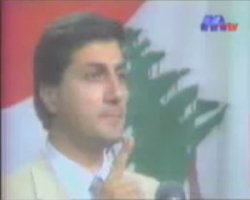Bashir Gemayel, the leader of the Lebanese Forces (LF) militia and former Lebanese president-elect, had a vision to deliver Lebanon from the ashes of its civil war, leading some to dub him “The Phoenix.”[i] Others have described him as being ruthless and convinced that he could reform and save Lebanon from the ravages of war.[ii] Regardless of one’s interpretations of Gemayel’s motives, he developed a larger than life persona whose voice still resonates with the hopes and aspirations of a bygone era.
This multimedia feature aims to illustrate how Gemayel articulated his vision through media and the spoken word, and how these techniques developed over his political career. It covers Gemayel’s career spanning from the days of the LF as a burgeoning military force mobilizing against the Syrian Army and PLO to its apex during the days of Gemayel’s short-lived foray into Lebanese presidential politics. Gemayel’s rhetoric is characterized by heavy repetition of key phrases, a wide dynamic range, and use of characters to personify larger trends. Yet over the course of his career, the tone and appeals used varied widely according to political context, the audience and Gemayel’s changing political and military role.
Bashir Gemayel and the Lebanese Forces
In order to counter the alliance between the Palestinians and the Lebanese National Movement (LNM), the Lebanese Forces was established in 1976 as the military wing of the Lebanese Front, a loose-knit alliance of predominantly Maronite militias. Gemayel emerged from one of Lebanon’s most influential political families at the forefront of a young generation of ambitious and idealistic Maronite leaders who sought to remake Lebanon in their image from the chaos of Lebanon’s civil war.[iii] After a power struggle between the country’s Christian militias that culminated with Gemayel’s July 1980 “Unification of the Rifle” campaign, he emerged as the leader of all independent Christian militias under the Lebanese Forces banner.[iv]
Gemayel’s LF became the most powerful militia in Lebanon, able to confront its two primary adversaries: the PLO and the Syrian Army.[v] As a statesman, Gemayel came to represent a political project that did not resonate with regional currents of Arabism, but instead grew out of a form of Lebanese nationalism rooted in its history as a Maronite homeland. This vision, however, grew to embrace an increasingly non-sectarian agenda and a more secular nationalist agenda as Gemayel advanced to a national role.[vi]
Video 1: The Occupation and the resistance (1979)
English translation: The occupation and the resistance (PDF)
An October 1979 documentary film entitled “The Occupation and The Resistance” is a window into the LF’s conception of its fundamental challenges and goals during this period. The film depicts Lebanon’s Maronite Christian community as under attack by a “double occupation” of Palestinian groups and the Syrian Army who have superior military strength. Arab states and the international community are painted as supportive of this scenario, magnifying the situation’s danger. During this period, these themes of ‘double occupation’ and ‘international abandonment’ were central to Gemayel’s discourse aimed at mobilizing and motivating his audiences.
This conception of a dual threat was particularly powerful because contemporary events resonated with an existing Lebanese Maronite mentality that saw the group as inheritors of an ancient civilization under siege.[vii] This conception of Lebanon as a ‘distinctive civilization’ resonates with themes stressed in the documentary that Lebanon is threatened by Pan-Arabism and a Palestinian presence.[viii]
The Cairo Agreement of 1969 provided Palestinian groups in Lebanon with de facto ‘state within a state’ status shortly before their expulsion from Jordan in 1970.[ix] By the mid-1970s these groups had become entangled in an internal crisis by acquiring allies within Lebanon and becoming the initial guardian for the progressive Lebanese National Movement (LNM) – a development that provoked hostility from the Maronite ‘right.’[x] The Syrian Army initially entered the conflict in Lebanon as a ‘stabilizing’ force in 1976, but Syrian-Maronite relations began to deteriorate in 1978 after the LF refused to disarm when the Syrian-led Arab Deterrent Force entered Beirut.[xi] Agitations between the two groups soon culminated with the Syrian army’s siege of east Beirut, an event highlighted in this documentary.[xii] By this time, the LF had become frustrated with the Carter administration’s perceived benign position on the Lebanese crisis.[xiii]
Observations and analysis:
The documentary begins with statistics on the demographics of Lebanon, meant to illustrate the military advantage of Palestinian and Syrian forces. Picturesque scenes of an idealized Maronite mountain village, church bells calling worshipers to prayer, are broken by sounds and images of war. A lecture by Gemayel follows on the state of affairs in the country, and a dramatized narrated ‘letter to home’ by a character on the front lines. The narratives are supported by footage allegedly taken from key engagements, such as Tal al-Za’atar in 1976, as well as the Syrian siege of East Beirut in 1978.[xiv]
The film uses facts and statistics, such as the Syrian army’s use of the heaviest Soviet-made artillery mortars known to warfare at that time, to support Gemayel’s theme of the asymmetry of the confrontation. The narrator also derides the international community, especially the superpowers, of selling out the freedom of Lebanon’s Christians “for a tank of gas.” [xv]
In addition to attributing the bombardment of East Beirut to Syrian forces, and images of charred Christian bodies to footage of Palestinians roaming the streets,[xvi] there is also a deliberate juxtaposition of text and image to depict the severity of the situation. For example, the word “extermination” is juxtaposed with the image of artillery fire and blood on the street, and footage of abandoned and destroyed buildings. Towards the end of the film Gemayel’s talk of the goals of a better Lebanon for “our children” is complimented with shots of amusement parks, and children playing in swimming pools.
The following themes can be drawn from this documentary: the need to fight and defeat a dominant aggressor, and the need to reverse international complicity with the status quo. The coupling of images and language to stress key points will later be paralleled in Gemayel’s speech through the use of repetition, manipulation of volume, and use of characters to put a human face on abstract concepts. However, the thematic content and delivery style will adapt to military and political developments.
Audio: The return from Zahle (1981)
English translation: The return from Zahle (PDF)
The Syrian army’s siege of Zahle came after a two-year lull in the violence between the Syrians and the Lebanese Forces. In 1981 Gemayel and his LF attempted to bridge an isolated military pocket in the Christian town with the Christian heartland by a road over Mt. Sannine. Due to its strategic location overlooking the Beirut-Damascus road, Syria had for some time been trying to subject Zahle to its authority.[xvii] While some argue Gemayel intentionally instigated the conflict, tensions came to a head after Syrian soldiers and Zahle residents were killed in a clash with Kataeb elements of the LF.[xviii] During the ensuing siege, a group of fewer than 100 LF fighters, along with Zahle’s townspeople, were able to hold off an overwhelming Syrian force for several months before international diplomacy diffused the crisis.
While Zahle was not a decisive military victory for either side, it set ‘red lines’ of deterrence between Israel and Syria at the beginning of the war in 1976, during which Israeli airpower came to the aid of Gemayel’s forces.[xix] The Zahle crisis also put the LF in the international spotlight by attracting media coverage and, ultimately, international intervention.[xx] This leads some to argue that the Zahle crisis prompted more direct international involvement from Israel and the U.S. in the Lebanon issue.[xxi]
Furthermore, the fact that Zahle was a predominantly non-Maronite - albeit Christian - town would prove useful to Gemayel in portraying the LF’s resistance as embodying a more national character. With a presidential election only a year away, the battle provided Gemayel an opportunity to cultivate his nationalist credentials in the hopes of gaining support from outside his constituency. Thus, the ‘victory’ of Zahle represents a crucial moment in the LF’s attempt to garner legitimacy on both the national and international levels. In fact, Zahle provided a useful backdrop, representing a microcosm of the greater Christian dilemma in Lebanon so dramatically portrayed in “The Occupation and the Resistance.” The following speech was given at the LF’s headquarters in East Beirut upon the return of the LF fighters from Zahle on June 30, 1981. This homecoming ceremony was allegedly covered by local and international media.[xxii]
Observations and analysis:
Given the international coverage devoted to the Zahle crisis, and in an ostensible move to project ‘victory’ to an international audience, Gemayel spoke in Modern Standard Arabic as opposed to the colloquial Lebanese dialect more readily spoken by his constituents. He delivers his message in a succinct manner, reading from a script. There are no moments of bellicose delivery that will later be witnessed at Don Bosco. Instead, Gemayel attempts to speak as a reserved, articulate, yet firm, leader to a broader Lebanese and international audience.
In the speech, Gemayel expresses gratitude to the international community for its role in diffusing the conflict. After repeating how events stemming from the siege, such as diplomatic efforts by the U.S. and Gulf states, Israeli sorties against Syrian positions, and Syria’s subsequent dispatching of surface-to-air missile batteries to the area, Gemayel proclaims that the Lebanese resistance acquired an international dimension as a result of the Zahle affair. He declares that, because of the efforts of the resistance, Zahle has become an “international city.” When speaking on the conflict’s international aspects, Gemayel repeats superlative phrases, increases the volume of his speech and repeats how the international bodies and entities responded to the crisis to fully express the town’s newfound international “dimension.”
Gemayel also frames the conflict as a Lebanese ‘victory’ that legitimizes resistance as a national project, claiming that all Lebanese desired to be Zahlawis at this time of glory. He lists at length the different entities within Zahle that fought and were martyred in the battle to paint the conflict as one that all Lebanese could identify with. After declaring that Zahle will now remain a free Lebanese city, he then goes on to proclaim that the nation is moving in the direction of the LF’s resistance. This opportunity to advance the message both nationally and internationally came at a crucial time for the organization. Coming off of the Christian infighting that marked the late 1970’s, and with an election year quickly approaching, the LF needed to advance its nationalist credentials. Meanwhile, the international attention garnered by the crisis increased military and diplomatic aid. Thus, Gemayel turned the relatively small battle of Zahle into a pivotal moment for the LF, and began advancing himself as a national leader.
Video 2: Camp Don Bosco (February 1982) part 1
Camp Don Bosco video part 2
English translation: Camp Don Bosco (PDF)
By early 1982, military and political developments converged to bring the prospect and necessity of a decisive victory to the top of the Lebanese Force’s agenda. The PLO had attained the apex of its prominence in the Arab world through the financial infrastructure and territorial base provided by Lebanon.[xxiii] In addition to being a much more disciplined and trained force, plans were being drawn for the Israeli invasion of south Lebanon to eliminate the PLO and solidify Gemayel’s chances of attaining the presidency. While the LF’s military mission was to rid Lebanon of all foreign forces, the removal of Syria’s presence in Lebanon also became an explicit precondition voiced by Gemayel for the election of a president in the upcoming 1982 elections.[xxiv] With these elections quickly approaching, these military and political factors demanded that the LF’s military preparedness be in top form.
Observations and analysis
While delivered within the somewhat insulated military setting of the Don Bosco boot camp, Gemayel’s speech touches on themes of dual threats and international abandonment first illustrated in “The Occupation and the Resistance,” but in a more explicit fashion. Compared to his “Return from Zahle” speech, Gemayel is more animated, and addresses his troops in the Lebanese dialect. Speaking to the soldiers, Gemayel labels the threat as “the desert,” an apparent reference to the surrounding Arab states and entities. He provides a cast of hypothetical characters that, for him, symbolize this desert: Nasser, Khomeini, and the Palestinians. Over the course of this first segment, Gemayel crescendos when he touches on the threat posed to the Maronite community, as a minority community, and the soldiers’ preparedness to confront and destroy the enemy. Here we see Gemayel’s trademark animated hand gestures accompanies his listing of threats posed by “the desert.” However, by stressing the level of preparedness of the recruits, and assuring them that they are part of a collective effort, Gemayel proclaims that the challenge of the Palestinian-Syrian threat will be vanquished.
In the second segment Gemayel links the military objectives of the LF to the presidency issue, insisting that the next Lebanese president should be one that is truly Lebanese, and not the implement of any of the Arab states or foreign powers. Again, Gemayel uses hand movements and structural repetition to reinforce his message. At times, Gemayel switches to Syrian dialect when addressing Syria’s perceived designs on the Lebanese presidency.
He begins this part of his speech stating, “Heyn ilwa’t ilyoom, bikoon ‘inna ra’ees – moo bas matloub, bas ma’boul”, which translates as, “This is the time today, for us to have a president – not only demanded, but accepted….” Here the pronunciation of “not only” as moo bas is a noticeable shift from the Lebanese way, which would be mish bas or minno bas. Gemayel’s pause immediately before using the phrase moo bas aids in highlighting this discrepancy for his listeners. The Syrian dialect is used again later when Gemayel states, “Iza Suriya khayoo badda ra’ees [ij]joumhouriyeh bi Loubnahn…”, which translates as, “If Syria wants a president in Lebanon….” Here Gemayel’s Syrian articulation of the term khayoo, meaning brother, doesn’t appear to have any role in this context as a nominal phrase as would its Lebanese equivalent khayee. [xxv] The pronunciation of Lebanon as Loubnahn, with a stress on the “a” sound, as opposed to Libnen, also marks a shift from Lebanese to the Syrian dialect. The seemingly arbitrary use of khayoo gives the object of Gemayel’s address a distinct Syrian quality. These attention-grabbing shifts, recognizable by his Lebanese audience, are likely intended to goad his listeners and again invoke the foreign threat.
In using the “desert” as a marker for military and political threats Gemayel, implies a risk to all sectors of Lebanese society, from the soldiers’ families to the democratic process vis-à-vis the presidency, and fits with the Lebanese Forces’ expanding political ambitions in Lebanon at the time. Identical themes reappear in Gemayel’s discourse once he becomes president-elect, albeit in a more sanitized and nuanced fashion.
Video 3: Speaking as Lebanese president-elect (September 8, 1982)
Speaking as Lebanese president-elect video part 2
English translation: Speaking as Lebanese president-elect (PDF)
In the run-up to being elected president, and after Israel forced the PLO out of Lebanon, Gemayel strove to maintain national credibility by reaching across sectarian lines and keeping his distance from Israel. Some argue that his popularity grew even outside Maronite ranks in the days following his election. Slogans, such as the liberation of Lebanon’s 10,452 sq. kilometers – one of the defining catchphrases of Gemayel’s discourse – resonated with many Lebanese perhaps for its appeal to territorial integrity over sectarian agenda.[xxvi] A speech given by Gemayel in September of 1982, shortly after being elected president and days before his assassination, reflects some of the relatively new ideas that the Lebanese Forces had on issues of governance in Lebanon. Speaking before members of Lebanon’s media establishment on Lebanon’s national television network Tele-Liban, Gemayel sought to speak as a statesman and not a military commander.
Observations and analysis
Addressing the nation via television, Gemayel emphasizes media responsibility, the need to streamline government institutions, and the hindrance of ineffective systems of patronage. His call for responsibility and citizen oversight stems from the LF’s proclaimed goal to eliminate corrupt “old style politics,” and presents himself as an agent of the state in front of the Lebanese flag. [xxvii] In this speech, Gemayel fluctuates between the systematic repetition of key words and phrases, and addressing the audience in a more casual, off-the-cuff manner.
At the beginning of his speech, again we see him use a character to connect with his audience. Here he uses Ahmad Saeed as a reference point for the concept of “bad journalism.” [xxviii] This is followed by the repetition of phrases and words that highlights the level of responsibility that Gemayel attributes to the media. He even attributes the Lebanese media’s previous irresponsibility in covering government officials, and failure to report on the ‘truth’ of the Lebanese situation, as contributing factors to the civil war. At the same time, he occasionally shifts gears to humorous passages that provide counterpoint to the gravity of the country’s history and future. Towards the end of the second segment, he attempts to convey a collective sense with structural repetition, saying, “our children will no longer be killed like they were killed in the past, our homes will no longer be destroyed like they were destroyed in the past, our sovereignty will no longer be violated like it was violated in the past.”
This more dressed-down, yet sincere, self-presentation by Gemayel marks his shift from sectarian military commander to statesman. His initial focus on the media’s role in providing accurate information he seeks to portray himself as a ruler dedicated to transparency. By proclaiming that he’ll be a hands-on, grassroots president, even inviting audience participation, he presents himself as a sincere political leader for all of Lebanon, and further distances himself from the more martial tone of his earlier speeches.
Conclusion
Many aspects of Bashir Gemayel’s speeches remained constant from his early days as a commander during the Lebanese civil war to his short-lived political career. While the context and audience ultimately shaped how his message was articulated, he often relied on the repetition of words, phrases, and patterns to emphasize his message, and the challenges faced by his Lebanese Forces militia and the wider Lebanese population. While at times he sought to grab the attention of the international community, he also attempted to connect with some of his audiences by framing the subject matter in everyday terms. Thus, it is perhaps his dexterity in the application of his rhetorical style that defines him as one of the Arab world’s most unique political speakers.
Pete Ajemian is a New York-based researcher and Contributing Editor for Arab Media & Society.
Click here for translations as a single document (PDF)
NB: All Arabic materials in this paper were translated by the author, with the assistance of a native Lebanese Arabic speaker. Some clips were were edited due to time constraints, and not all video discussed above is included. The full videos may be found at their original YouTube URLs as follows:
“The Occupation and the Resistance”
http://www.youtube.com/watch?v=tLr70UAk3iE&feature=related
“Return From Zahle”
Audio: http://www.alcc-research.com/files/21A.mp3
Video 1:http://www.youtube.com/watch?v=EPhjzoNlk0s
Video 2: http://www.youtube.com/watch?v=CIBukKajncU&feature=related
“Don Bosco”
http://www.youtube.com/watch?v=cQq0-cD2WqQ&feature=related
http://www.youtube.com/watch?v=AyREEP-2Evc&feature=related
“Tele-Liban”
Video 1: http://www.youtube.com/watch?v=5VjXOof6JBY&featuref=related
Video 2:http://www.youtube.com/watch?v=UnzeRi7N7bo&feature=related
 Arab Media & Society The Arab Media Hub
Arab Media & Society The Arab Media Hub





